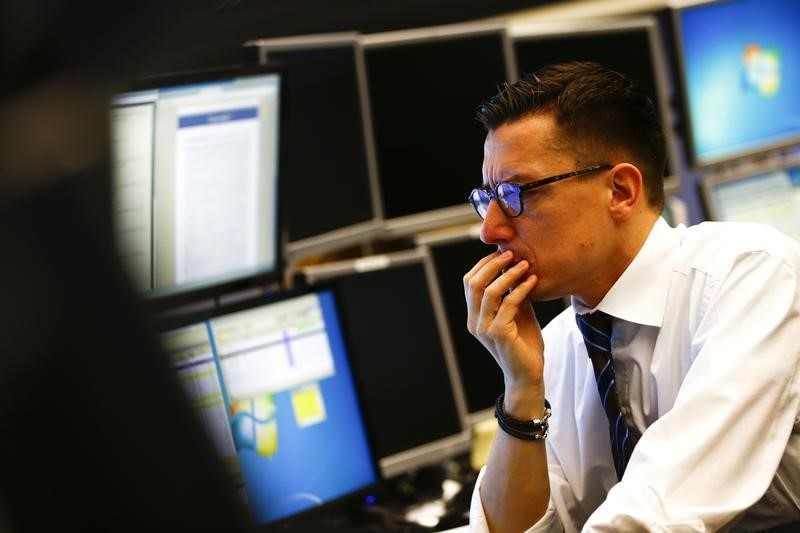* Graphic: World FX rates in 2017 http://tmsnrt.rs/2egbfVh
* U.S. President Trump steps up rhetoric on North Korea
* Stocks biggest weekly fall, VIX biggest rise since Trump election
* European shares open with losses
* Dollar hits 2-month low vs yen ahead of July CPI data
* Yen and Swiss franc rise, gold holds Thursday's gains
* Oil retreats as oversupply concerns linger
By Marc Jones
LONDON, Aug 11 (Reuters) - World stocks tumbled for a fourth day and were on course for their worst week since November, as the escalating war of words over North Korea drove investors on Friday toward the yen, the Swiss franc and gold.
Europe's main London, Frankfurt and Paris markets started between 0.5 and 1.1 percent lower .EU and Germany's ultra-safe 10-year government bonds were trading at their highest prices since June. GVD/EUR
U.S. President Donald Trump issued a new verbal warning to Pyongyang on Thursday, saying that his previous promise to unleash "fire and fury" may not have been strong enough after North Korea responded with a threat to land a missile near the U.S. Pacific territory of Guam. markets were closed for a holiday but the in-demand yen powered on, hitting an eight-week high of 108.91 yen to the dollar JPY= , adding to its biggest weekly gain since May. FRX/
The yen tends to benefit during times of geopolitical or financial stress as Japan is the world's biggest creditor nation and there is an assumption that Japanese investors there will repatriate funds should a crisis materialise.
The Swiss franc CHF= , the other traditional currency safety-play, has benefited too. Two weeks ago it saw its biggest weakly fall against the euro EURCHF= since the start of 2015. This week has been its biggest rise since June 2016.
"Geopolitical tensions are the main focus: the S&P 500 was down 1.5 percent last night and many investors are becoming risk averse," said DZ Bank strategist Andy Cossor.
Many world stock markets have hit record or multi-year highs in recent weeks, leaving them vulnerable to a sell-off, and the tensions over North Korea have proved the trigger.
The CBOE Volatility Index .VIX , the most widely followed barometer of expected near-term U.S. stock market volatility, hit its highest mark since Nov. 8, when Trump was elected president.
The Chinese volatility gauge .VXFXI jumped by the most since January 2016 to its highest level in more than seven months. The euro zone's version .V2TX is the highest since April, when France's election was rattling the region.
Overnight, MSCI's broadest index of Asia-Pacific shares outside Japan .MIAPJ0000PUS had skidded 1.55 percent, its biggest one-day loss since mid-December, to leave it down 2.5 percent for the week.
"What has changed this time is that the scary threats and war of words between the U.S. and North Korea have intensified to the point that markets can't ignore it," said Shane Oliver, head of investment strategy at AMP Capital in Sydney.
"Of course, it's all come at a time when share markets are due for a correction, so North Korea has provided a perfect trigger."
NEW CUBAN CRISIS?
South Korea's KOSPI .KS11 fell 1.8 percent to an 11-1/2-week low, but its losses for the week are a relatively modest 3.2 percent. "Pretty remarkable, perhaps even extraordinary, considering," said fund manager BlueBay strategist Tim Ash.
The Korean won KRW=KFTC also continued to skid, down 0.45 percent to 1,147.2, falling below its 200-day moving average for the first time in a month.
Australian shares .AXJO were down 1.3 percent, set for a weekly loss of 0.6 percent and Chinese and Hong Kong bluechips lost 1.6 percent .CSI300 and 1.9 percent .HSI respectively.
A Chinese state-run newspaper said on Friday that China should make clear that it will stay neutral if North Korea launches an attack that threatens the United States, but that if the U.S. attacks first and tries to overthrow North Korea's government, China will prevent it doing so. situation is beginning to develop into this generation's Cuban Missile crisis moment," ING's chief Asia economist Robert Carnell wrote in a note.
The market's backstop safety asset, gold XAU= , edged up to its latest two-month high of $1,288 an ounce. It soared over 2 percent in the previous two sessions, and is set for a weekly gain of 2.25 percent.
Crude futures extended losses on fears of slowing demand and lingering concerns over a global oversupply meanwhile.
U.S. crude CLc1 was down 0.9 percent at $48.16 per barrel, on track for a weekly loss of 2.9 percent.
Global benchmark Brent LCOc1 also fell 0.9 percent to $51.44, after Thursday's 1.5 percent drop. It is poised to end the week down 1.9 percent. The industrial bellwether metal copper was set for its first weekly drop in five weeks. MET/L
For Reuters Live Markets blog on European and UK stock markets see reuters://realtime/verb=Open/url=http://emea1.apps.cp.extranet.thomsonreuters.biz/cms/?pageId=livemarkets
<^^^^^^^^^^^^^^^^^^^^^^^^^^^^^^^^^^^^^^^^^^^^^^^^^^^^^^^^^^^ Fear and fury" costs global markets $1 trillion
http://reut.rs/2fxcDUH
^^^^^^^^^^^^^^^^^^^^^^^^^^^^^^^^^^^^^^^^^^^^^^^^^^^^^^^^^^^>
